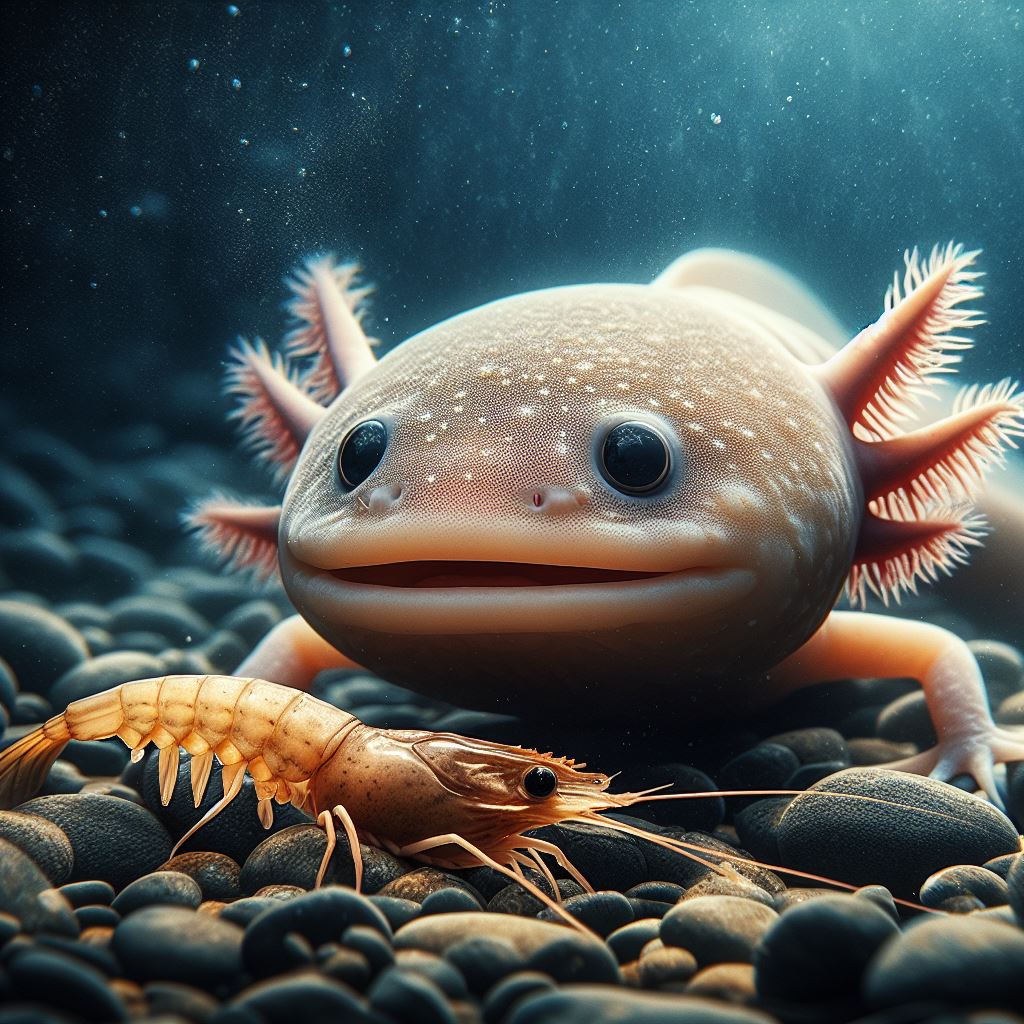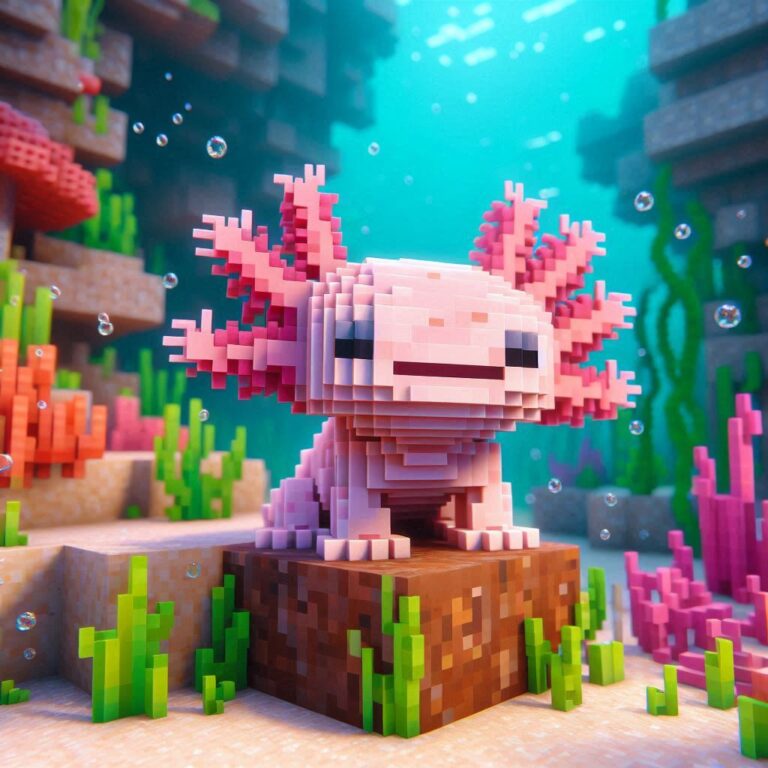
Whether axolotls can live with shrimp depends on various factors such as tank size, water parameters, and the behavior of both species. While it is possible to house them together in a well-planned setup, it’s essential to consider the potential risks and compatibility issues. Axolotls are carnivorous and may see shrimp as prey, posing a risk of predation. Additionally, shrimp’s activity and breeding behaviors could stress axolotls, especially if the tank lacks hiding places or is too small. However, with proper consideration of habitat requirements, feeding strategies, and careful monitoring, it is feasible for axolotls and shrimp to coexist peacefully in a shared tank.
Habitat Requirements: Axolotls vs. Shrimp
Axolotls and shrimp may come from similar aquatic environments, but their habitat requirements differ significantly. Axolotls are amphibians native to freshwater lakes and ponds in Mexico, preferring cool temperatures ranging from 60°F to 68°F (15°C to 20°C). They require spacious tanks with ample floor space for swimming and a soft substrate to prevent injury to their delicate skin. In contrast, shrimp, such as cherry shrimp or ghost shrimp, are typically found in tropical freshwater habitats with warmer temperatures around 72°F to 78°F (22°C to 26°C). They thrive in densely planted aquariums with plenty of hiding spots and prefer a substrate that allows them to sift through for food particles. Balancing these diverse habitat needs can be challenging when considering housing them together. A compromise in temperature and habitat setup must be achieved to ensure the well-being of both species.
Tank Size and Setup
Choosing the right tank size and setup is crucial for housing axolotls and shrimp together. Axolotls are relatively large amphibians and can grow up to 12 inches (30 centimeters) or more, requiring spacious tanks with a minimum capacity of 20 gallons for a single adult axolotl. These tanks should have a long footprint rather than tall to accommodate their bottom-dwelling nature. Additionally, axolotls are sensitive to water quality, so a robust filtration system is essential to maintain pristine conditions. On the other hand, shrimp are much smaller and can thrive in smaller tanks, but they are highly active and benefit from densely planted aquariums with hiding places to feel secure. When housing them together, providing adequate space and hiding spots for both species is crucial to reduce stress and aggression.
Water Parameters
Maintaining suitable water parameters is vital for the health and well-being of both axolotls and shrimp. Axolotls prefer cool, clean water with pH levels ranging from 6.5 to 8.0 and minimal ammonia and nitrate levels. They are sensitive to sudden changes in water chemistry, so regular monitoring and water changes are necessary. Shrimp, on the other hand, are more tolerant of a wider range of water parameters but thrive in stable conditions with pH levels around 7.0 to 8.0. They are particularly sensitive to copper, so medications and fertilizers containing copper should be avoided in shrimp tanks. Finding a balance in water parameters that suits both species can be achieved through careful monitoring and adjustment of filtration and water change routines.
Hiding Places
Providing hiding places is essential for both axolotls and shrimp to feel safe and reduce stress in the aquarium. Axolotls are nocturnal creatures and spend much of their time hiding during the day, emerging at night to forage for food. They prefer caves, PVC pipes, or large plant leaves where they can retreat and rest undisturbed. Shrimp also benefit from hiding spots, especially during molting and breeding periods when they are vulnerable to predation. Live plants such as java moss, driftwood, and ceramic caves provide excellent hiding places for shrimp to seek refuge. When setting up the tank, it’s crucial to arrange hiding spots in different areas to prevent territorial disputes and ensure both species have access to safe spaces.
Shrimp Behavior: How It Affects Axolotls
Shrimp behavior can have significant implications for axolotls sharing the same tank. While shrimp are generally peaceful creatures, their constant movement and activity may trigger curiosity or predatory instincts in axolotls. Axolotls, being opportunistic predators, might view shrimp as potential prey, especially if they are small enough to fit into their mouths. This can lead to stress for the shrimp and potential harm if the axolotl attempts to catch them. Additionally, shrimp may compete with axolotls for food, particularly if they are scavenging for the same food items. Understanding shrimp behavior and how it interacts with axolotls is essential for creating a harmonious tank environment.
Feeding Dynamics
Feeding dynamics play a crucial role in the relationship between axolotls and shrimp in a shared tank. Axolotls are carnivorous and primarily feed on live or frozen meaty foods such as bloodworms, earthworms, and small fish. They have poor eyesight and rely on movement to detect prey, making shrimp vulnerable if they venture too close. While axolotls may consume small shrimp as part of their diet, overfeeding can lead to obesity and health issues. On the other hand, shrimp are omnivorous scavengers and feed on algae, detritus, and leftover food particles. They are agile and efficient scavengers, often outcompeting axolotls for food if not adequately fed. Balancing the feeding regimen to ensure both species receive adequate nutrition without overfeeding is essential for their well-being.
Compatibility with Axolotl Temperament
The compatibility of shrimp with axolotl temperament depends on various factors such as tank size, individual personalities, and feeding strategies. Axolotls are generally solitary and territorial creatures, preferring to have ample space to themselves. While they may tolerate the presence of shrimp in their tank, they may also view them as competition for resources or even as potential prey. Aggressive or hungry axolotls may chase or nip at shrimp, leading to stress or injury. However, some axolotls may show little interest in shrimp, coexisting peacefully in the same tank. Understanding the temperament of both species and providing adequate hiding places can help mitigate potential conflicts and ensure a harmonious tank environment.
Breeding Behavior
Breeding behavior in shrimp can impact the dynamics of a mixed species tank with axolotls. Shrimp are prolific breeders and can quickly multiply under the right conditions, leading to an increase in population density within the tank. While this can provide a natural food source for axolotls, it can also result in overcrowding and competition for resources. Additionally, breeding behavior, such as molting and mating, can make shrimp more vulnerable to predation or aggression from axolotls. Providing ample hiding places and monitoring population growth can help prevent overcrowding and maintain a balanced ecosystem within the tank. Understanding the breeding behavior of shrimp and its potential impact on axolotls is essential for successful cohabitation.
Dietary Differences Between Axolotls and Shrimp
Understanding the dietary differences between axolotls and shrimp is crucial for maintaining their health and well-being in a shared tank. Axolotls are carnivorous amphibians that primarily feed on live or frozen meaty foods such as bloodworms, earthworms, and small fish. They have a voracious appetite and require a diet high in protein to support their rapid growth and metabolism. On the other hand, shrimp are omnivorous scavengers that feed on algae, detritus, and leftover food particles. They have a more varied diet and can thrive on plant matter as well as animal protein. Balancing the nutritional needs of both species and providing a diverse diet is essential for their overall health and vitality.
Axolotl Diet
Axolotls have specific dietary requirements to ensure their health and well-being. As carnivorous amphibians, they require a diet rich in animal protein to support their growth and metabolism. Live or frozen meaty foods such as bloodworms, earthworms, brine shrimp, and small fish are excellent choices for axolotl diet. These foods should be offered in appropriate sizes to prevent choking or overfeeding. Axolotls may also benefit from occasional supplementation with vitamin and mineral supplements to ensure they receive all essential nutrients. It’s essential to monitor their feeding behavior and adjust their diet accordingly to maintain optimal health.
Shrimp Diet
Shrimp have a more varied diet compared to axolotls, as they are omnivorous scavengers that feed on a variety of organic matter. In the wild, shrimp feed on algae, detritus, plankton, and small invertebrates found in their habitat. In captivity, they can thrive on a diet of commercial shrimp pellets, algae wafers, blanched vegetables such as spinach or zucchini, and occasional protein-rich foods like bloodworms or brine shrimp. Providing a balanced diet with a mix of plant and animal matter is essential for shrimp health and vitality. Additionally, shrimp may benefit from grazing on live plants in the aquarium, which can provide natural hiding places and supplemental nutrition.
Feeding Strategies
Developing effective feeding strategies is essential for ensuring both axolotls and shrimp receive adequate nutrition in a shared tank. It’s essential to consider the feeding habits and dietary preferences of both species when planning feeding times and offering food. For axolotls, feeding should be done sparingly to prevent overfeeding and water quality issues. Offering a varied diet of live or frozen meaty foods several times a week is ideal. Shrimp, on the other hand, can be fed daily or every other day with a mix of commercial shrimp pellets, blanched vegetables, and occasional protein-rich treats. Providing sinking pellets or placing food in multiple locations in the tank ensures both species have access to food without competition. Monitoring feeding behavior and adjusting the feeding regimen as needed is crucial for maintaining a healthy and balanced ecosystem in the tank.
Potential Risks of Housing Axolotls and Shrimp Together
While it’s possible to house axolotls and shrimp together in the same tank, there are several potential risks that need to be considered. These risks include predation, disease transmission, and stress inducement, all of which can impact the health and well-being of both species. Understanding these risks and taking appropriate precautions is essential for maintaining a harmonious tank environment.
Predation Risk
One of the primary risks of housing axolotls and shrimp together is the potential for predation. Axolotls are carnivorous amphibians with a voracious appetite, and they may view shrimp as potential prey. Even if well-fed, axolotls may still exhibit hunting behaviors towards shrimp, especially if they are small enough to fit into their mouths. This predation risk can lead to stress and injury for the shrimp, as well as potential population control issues if the axolotls consume too many shrimp. Providing ample hiding places and monitoring their interactions can help mitigate the risk of predation.
Disease Transmission
Another risk associated with housing axolotls and shrimp together is the potential for disease transmission between the two species. While both axolotls and shrimp are relatively hardy creatures, they can still be susceptible to various diseases and parasites. Housing them together increases the likelihood of disease transmission, especially if one species is already carrying a pathogen. Poor water quality, stress, and overcrowding can further exacerbate the risk of disease outbreaks. Regular monitoring of water parameters, quarantine procedures for new additions, and maintaining a clean environment are essential for preventing disease transmission.
Stress Inducement
Stress can have detrimental effects on the health and well-being of both axolotls and shrimp. In a shared tank environment, both species may experience stress due to competition for resources, territorial disputes, or predation risk. Axolotls may become stressed if they feel threatened or if they are unable to find adequate hiding places. Similarly, shrimp may experience stress if they are constantly harassed or chased by axolotls. Providing sufficient hiding places, maintaining stable water parameters, and monitoring their behavior can help reduce stress levels in both species. Additionally, separating aggressive individuals or providing separate tanks may be necessary to minimize stress inducement.
Temperature and Water Quality Considerations

Maintaining optimal temperature and water quality is essential for the health and well-being of both axolotls and shrimp in a shared tank. Axolotls are cold-blooded amphibians that prefer cooler water temperatures ranging from 60°F to 68°F (15°C to 20°C). In contrast, shrimp typically thrive in warmer water temperatures ranging from 72°F to 78°F (22°C to 26°C). Balancing these temperature preferences can be challenging but crucial for creating a suitable environment for both species. Additionally, monitoring water quality parameters such as pH, ammonia, nitrite, and nitrate levels is essential for preventing stress, disease, and potential conflicts between axolotls and shrimp.
Optimal Temperature Range
The optimal temperature range for axolotls and shrimp varies due to their different habitat preferences. Axolotls prefer cooler water temperatures similar to their native freshwater habitats in Mexico, ranging from 60°F to 68°F (15°C to 20°C). At temperatures outside this range, axolotls may become stressed, lethargic, or more susceptible to disease. On the other hand, shrimp thrive in warmer water temperatures ranging from 72°F to 78°F (22°C to 26°C). Warmer temperatures help stimulate their metabolism and promote breeding activity. Finding a suitable compromise temperature within this range that accommodates the needs of both species is essential for maintaining a harmonious tank environment.
Water Quality Parameters
Monitoring water quality parameters is critical for ensuring the health and well-being of axolotls and shrimp. Both species are sensitive to changes in water chemistry, so maintaining stable parameters is essential. Key water quality parameters to monitor include pH, ammonia, nitrite, and nitrate levels. Axolotls prefer slightly alkaline water with pH levels ranging from 6.5 to 8.0, while shrimp tolerate a wider range of pH levels but thrive in stable conditions. High levels of ammonia and nitrite can be toxic to both species, leading to stress, illness, or even death. Regular water testing and maintenance, including partial water changes and proper filtration, are essential for preventing water quality issues in the tank.
Compatibility of Requirements
Balancing the temperature and water quality requirements of axolotls and shrimp is essential for their cohabitation in a shared tank. While their preferences may differ, it is possible to create a suitable environment that accommodates the needs of both species. Selecting an appropriate temperature within the overlapping range of 72°F to 68°F (20°C to 22°C) can help meet the needs of both axolotls and shrimp. Additionally, maintaining stable water quality parameters within acceptable ranges ensures a healthy and thriving ecosystem for both species. Providing adequate filtration, regular water testing, and proper tank maintenance are essential for ensuring compatibility and promoting the well-being of axolotls and shrimp in the same tank.
FAQs
Q. Can axolotls eat shrimp?
A. Axolotls are carnivorous and may see shrimp as prey. It’s not recommended to house them together unless you’re prepared for potential predation.
Q. Do axolotls and shrimp require the same water parameters?
A. Axolotls prefer cooler water with minimal current, while shrimp typically thrive in warmer water with some flow. Balancing these preferences can be challenging in a shared tank.
Q. Will shrimp bother axolotls?
A. Shrimp may not directly bother axolotls, but their activity and breeding behaviors could stress axolotls, especially if the tank is too small or lacks hiding spots.
Q. What size tank is suitable for housing axolotls and shrimp together?
A. A larger tank with plenty of hiding places and ample space for both species to move around is ideal. A minimum of 20 gallons is recommended for a mixed species setup.
Q. Can axolotls and shrimp breed together?
A. No, axolotls and shrimp cannot interbreed. However, shrimp may reproduce rapidly in the tank, which could affect water quality and the overall ecosystem.
Q. Are there any diseases that axolotls and shrimp can transmit to each other?
While the risk is relatively low, there is a potential for disease transmission between axolotls and shrimp, especially if one species is already carrying a pathogen.
Q. How should I feed axolotls and shrimp in the same tank?
A. It’s best to offer separate feeding areas to prevent competition and ensure both species receive adequate nutrition. Axolotls may eat any small shrimp that they can catch.
Q. Can axolotls and shrimp live together peacefully?
A. While it’s possible for them to coexist without major issues, careful consideration of tank size, habitat setup, and monitoring of behaviors is essential to ensure their well-being.
Q. Do axolotls and shrimp interact with each other?
A. Axolotls may show curiosity towards shrimp, but interactions are typically limited. Shrimp may be more active in the presence of axolotls if they feel safe.
Q. What should I do if I notice aggression between axolotls and shrimp?
A. If aggression becomes a problem, consider separating the species into different tanks. Monitor their behavior closely and intervene if necessary to prevent injuries.
Conclusion
In conclusion, while housing axolotls and shrimp together in the same tank presents unique challenges, it is indeed possible with careful planning, consideration, and monitoring. Understanding the differences in habitat requirements, dietary preferences, behavior, and temperature and water quality needs of both species is essential for creating a harmonious tank environment. By providing ample hiding places, balancing feeding strategies, and maintaining stable water parameters within acceptable ranges, aquarists can foster a thriving ecosystem where both axolotls and shrimp can coexist peacefully.

Hassan Shah carries over four years of hands-on expertise in caring for axolotls, guided by his cherished companion ‘Little Bruno,’ a thriving axolotl under his attentive care for three years.



